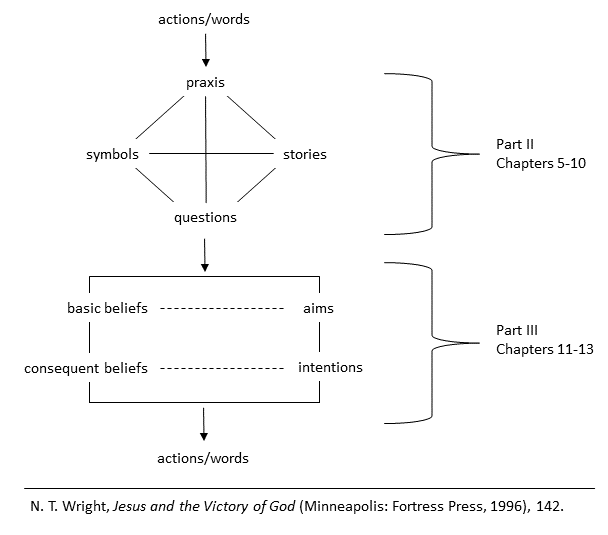Reading Wright, JVG, Chapter 4
Prodigals and Paradigms
Chapter 4 of Jesus and the Victory of God (pp. 125-44) uses the well-known parable of the prodigal son for Wright to illustrate the task ahead as he completes Part I of this book.
It is a well-known story, recorded in Luke 15, as the last-of-three in response to the grumbling of the Pharisees and scribes (15:2). I had previously read this story with an interpretation of younger son=sinners/older son=Pharisees/God forgives sinners/why are you being so difficult? Given the context, that is a surface issue. But Wright suggests we view it with “the exodus itself [as] the ultimate backdrop… and… exile and restoration [as] the main theme.” (p. 126). In other words, reading it through a first-century Jewish worldview.
Both sons act shamefully. The younger, by asking for his inheritance early, wishes his father dead; then returns home, “threatening to disgrace the whole family in the eyes of the village.” (p. 129) The older “shames his father, by quarrelling with him in public, and in his turn suggesting that he wished the father dead so that he could at last enjoy his share of the property.” (p. 129) Yet the father is generous to both. Given the heavy emphasis in the culture on honor/shame and the multiple story points, it would be unthinkable for a Jewish father to act this way. The father can only represent Israel’s generous, merciful, forgiving God.
Now for the worldview shift. It is through Jesus that the exile is ending. Not through proper temple worship (Sadducees), Torah observance (Pharisees), fighting against Rome (Zealots), or complete separation from everyone (Essenes). Whether you are a Jew whose descendants had returned from physical exile [older brother], or a Samaritan whose Jewish descendants were left behind and ended up ethnically mixing with Gentiles [younger brother], Jesus wants both to join the party—the exile is ending and it is time to rejoice! To not do so is to continue in exile and be a Samaritan! To not do so is to harden one’s heart like Pharaoh (exodus backdrop). And worst of all, Jesus claims that he has the authority to end the exile—“when he does all this, Israel’s god is doing it.” (p. 130) Just how is one to know Jesus is speaking truly?
Wright notes the presence of “the strange announcement of resurrection, twice within the parable.” (15:24, 32; p. 131) Just as the work of God in ending the exile is like the dead coming to life (Ezekiel’s dry bones anyone?), likewise the work of the Son will be vindicated—demonstrated—when He too is brought back to life. You will know God is present—that He is the one doing it—when you see resurrection!
The parable is designed to shock and offend Jewish sensibilities, and it does that quite well. But it does more, breaking open the implicit worldview stories that a first-century Jew tells oneself to shift their paradigm. This is what Jesus does repeatedly and one Wright will examine closely.
Where are we headed to next? Wright introduced his approach back in NTPG, Chapter 5, and I have reproduced his visualization of it below in Figure 1 (with my additions on the right for Parts/Chapters ahead of us in JVG):
Wright argues one’s actions and words can reveal one’s worldview (though exposed more explicitly through the diamond’s parts); worldviews, in turn, drive's one’s beliefs and the activity that one is consciously aware of (worldview tends to be the thing through which we see). These in turn drive further actions and words. (It may be helpful to review my more detailed post on his chapter introducing this idea.) In NTPG, Wright discussed and carefully walked through each of these for the first century Jewish mindset (NTPG chapters 6-10). Wright now begins in the next chapter and through part II of this book, to “plot Jesus’ distinctive mindset within the Jewish worldview of his day.” (p. 142) And so next time, we will cover praxis.
Chapter 1: Jesus Then and Now
Chapter 2: Heavy Traffic on Wredebahn: The ‘New Quest’ Renewed
Chapter 3: Back to the Future: The ‘Third Quest’
Chapter 4: Prodigals and Paradigms
Chapter 5: The Praxis of a Prophet
Chapter 6: Stories of the Kingdom (1): Announcement
Chapter 7: Stories of the Kingdom (2)
Chapter 8: Stories of the Kingdom (3): Judgment and Vindication
Chapter 9: Symbol and Controversy
Chapter 10: The Questions of the Kingdom
Chapter 11: Jesus and Israel: The Meaning of Messiahship
Chapter 12: The Reasons for Jesus’ Crucifixion
Chapter 13: The Return of the King
Chapter 14: Results

